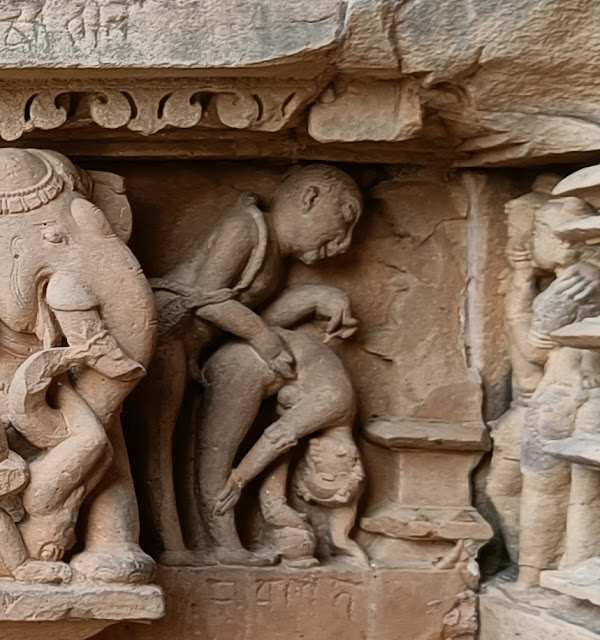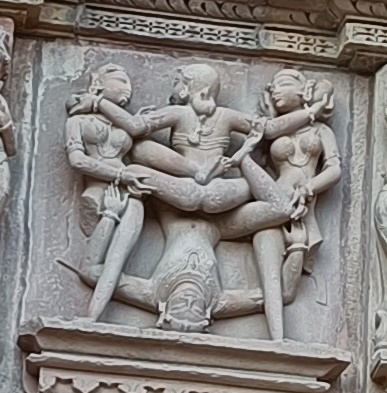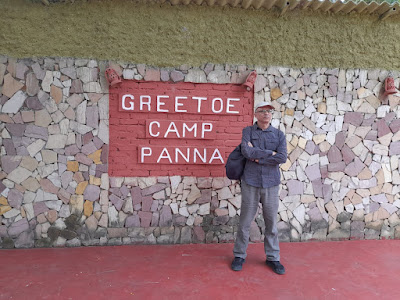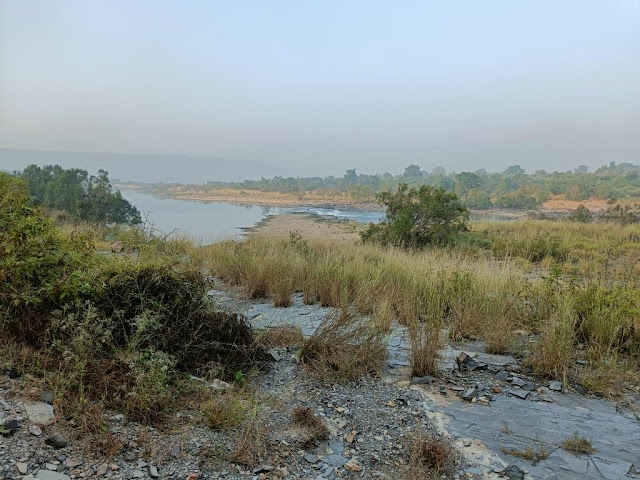 |
The Khajuraho Temples: Madhya Pradesh |
To say that Khajuraho is a mysterious and misunderstood place, would not be
entirely inaccurate. For many, even the phrase erotic temple would seem like an
oxymoron.
But the way we are able to explain/justify seemingly incongruous, concepts of
ancient Indian culture, mythology and history knows no bounds.
A guy who charms 20,000 women simultaneously preaches dharma to a most virtuous
guy who gambled away his only wife whom he was sharing with his four brothers.
Another guy who promises someone to help win a duel by shooting an arrow
surreptitiously is considered the epitome of righteousness. All these seeming
incongruities have a sublime explanation, though difficult to digest for most.
So therefore, if amazingly graphic erotica is etched in stone, rubbing shoulders
with bonafide gods and goddesses, the explanations are equally mind-boggling
Contrary to popular belief, information about the erotica of the famed temples
of Khajuraho is not easy to obtain on the internet. In fact there's downright
misinformation saying that photography is strictly prohibited, or that there
are only a few panels on the outer side of the inner walls...
Nothing could be farther
from the truth.
 |
The Western Temple complex |
Built in the ninth century by Chandela kings, about 25 of the original 85 temples in two clusters have withstood the ravages of the marauders through the centuries. Apparently this was due to oversight of these two clusters by the destructive invaders and downfall of the power of the local rulers which ensured that no looter was interested in coming this way.
The complex became overgrown by a forest thereafter and
was forgotten till the nineteenth century, when a British surveyor called TJ Franklin
rediscovered them in 1819. (A similar story of overgrowth and rediscovery by British
also applies to the Hampi temples in Karnataka)
What remains
today, presents a marvellous and adequate evidence of the architectural and
artistic prowess of the people of that time, in this part of the country. Before we get carried away, let it be clarified that barely 10 % of the Khajuraho
sculptures are erotica. So what is the rest and why are they there? This, and many other unanswered questions is what still takes lot of people to
this rather remote hamlet in central India, in an era when erotica is available
to everyone at the click of a button.
Apart from the fact that the local airport is closer to the town than the railway station, the one thing stands out about Khajuraho temples is that the approach is neither through a narrow crowded street nor attended with scores of beggars and filth as would be expected of a temple.
In fact they are
not temples at all; rather they are ASI monuments where there's no actual
worship. Only one structure is a designated temple, that too outside the perimeter
where the monuments sprawl on a 25 acre campus.
The architecture called Nagara style, was prevalent in India since the Gupta
period. One look at it and the superstructure would remind you of the Jagannath
Puri and most other temples in Benares.
 |
The temples stand on a firm granite base and are made from sandstone mined from
the nearby Panna mines which has a slightly yellowish red shade as opposed to
the Rajasthan sandstone seen in the Red forts at Agra and Delhi. The deep excavation
of sand done for constructing these nearly seven storey high constructions had
led to the creation of 85 lakes, which are no longer seen.
The intricate carvings adorning the entire outer and inner surface of all the
temples depict all imaginable themes starting with Gods and Goddesses, everyday
events, and mythological legends. The scenes from war are most numerous and
varied.
 |
Ganesha the musician: The wave on the belly depicts the effort of singing |
 |
Narasimha avatar |
 |
Goddess |
 |
 |
Vishnu: the main diety |
 |
Elephant file stopping abruptly: The front ones collided, the passengers swaying |
Apsaras which adorn all the pillars are broadly categorized as Gajagamini- thick thighs or Damini- slender thighs. Needless to say, all are voluptuous.
 |
Intricately carved maiden. Small one is the handmaid |
Slipped randomly among the sculptures are what is described by the guides as intimate scenes or depictions of lovemaking positons.
 |
Erotica panel just above the Devi panel |
 |
Intimate moments |
 |
Intimate moments |
 |
Kamasutra positions |
 |
Mission impossible |
Those which severely stretch the imagination are referred to as Kamasutra positions or Tantric practices. One among them is dramatically described as Mission Impossible!
 |
Viagra being prepared with orgies in progress |
 |
Tantric pose |
 |
Lovemaking , assistant feeling shy |
 |
Both assistants pleasuring themselves |
 |
Female assistant pleasuring herself |
 |
Male assistant pleasuring himself |
 |
Assistants assistants also joining in |
 |
The Rishi pleasuring his pupil: Pupil begging forgiveness! |
 |
Lesbian love |
 |
Vaishya depicted with clothes slipped down |
 |
Vishakanya with clothes slipping and scorpion on thigh |
 |
Female getting pleasured by a dog; resulting in punishment |
 |
Male bestaility. Horrified assistant taking a sneak peak |
 |
| The bottom panel on pale stone at the beginning ; the middle panel on red stone as act intensifies; the top panel in white colour as the lovemaking ends with blissful expression on the face |
 |
Female flute player: Maid listening to the music |
Our guide
informed us that Osho (Acharya Rajneesh) spent four years at Khajuraho perhaps seeking knowledge and inspiration on his preferred path to spiritual enlightenment. He would interact extensively with the guides and have discussions regarding the
deeper/spiritual aspects of the sculptures.
Sculpture as an art form is almost as old as humankind, and there are excellent
specimens from every period of civilization all over the world. From what I
have seen, Egypt is full of exquisite ancient sculptures and paintings, and the rest are in
European museums. There are several other temples in India of the same period where a few such sculptures can be seen. But nowhere other than India, do we come across of a public display of erotica
especially commissioned by the rulers.
A sculpture reveals the ability of the artist to convert his ideas onto stone.
But what is permitted to be carved and where, depends entirely on the person
supporting that art. That places the Chandela and similar Indian rulers in a rather exclusive group who could resist the hypocrisy of social taboo.
The purpose of erotic temple art has been vigorously debated with views supporting the most philosophical to the most banal explanations.
Could it just be a depiction and celebration of the fundamental basic instinct?
As Sigmond Freud said, "sometimes a cigar is just a cigar"!!
Tour date: 08 Nov 2022
Camera: Oneplus Nord2
Traveler Tips:
1. All temples in the main (Western complex ) are within one perimeter,
at walkable distance. The Eastern complex has some temples with Jain deities.
2. Photography is allowed.
3. Open all days sunrise to sunset
4. Guides are expensive but worthwhile. Rs 1500.
5. Western complex can be seen in 2 1/2 hours.
 |


























